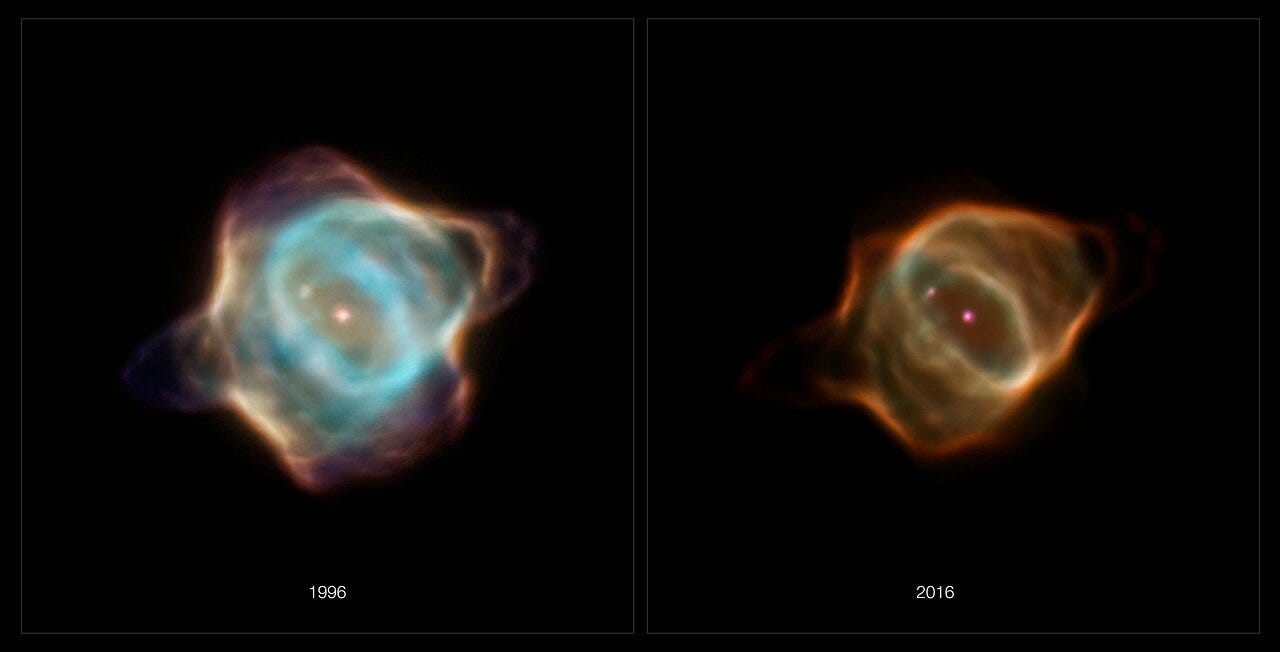
NASA, ESA, Balick (University of Washington), Guerrero (Instituto de Astrofísica de Andalucía), and G. Ramos-Larios (Universidad de Guadalajara)
- A team of astronomers used the Hubble Space Telescope to capture images of a nebula dimming quickly over just 20 years.
- One researcher called the rapid fading “very, very dramatic, and very weird.”
- Visit Business Insider’s homepage for more stories.
Astronomers often study changes that take place over vast stretches of time: Stars, for instance, can take millions of years to form and billions more to die.
But a team of astronomers recently captured a much speedier process. NASA reported last week that the Stingray Nebula, which is 18,000 light-years from Earth and located near the southern constellation Ara, has dimmed remarkably fast, fading over just 20 years.
The difference is visible in images taken by the Hubble Space Telescope in 1996 and 2016.
“This is very, very dramatic, and very weird,” Martín A. Guerrero, a member of the research team and professor at the The Institute of Astrophysics of Andalusia in Spain, said in a NASA press release. “What we’re witnessing is a nebula’s evolution in real-time. In a span of years, we see variations in the nebula. We have not seen that before with the clarity we get with this view.”
The GIF below captures the nebula’s dimming.
A cloud surrounding a dying star
A nebula is a giant cloud of gas and dust in space. Some nebulae form as stars die: As a star's core cools, it starts to shed its outer layers, which disperse to form the cloud. Nebulae are also the nurseries in which baby stars form.
The Stingray Nebula, formally known as Hen 3-1357, surrounds a dying star - a type known as a planetary nebula. Such nebulae absorb ultraviolet radiation from their star as it dies, causing them to glow.
Researchers determined Stingray to be the youngest known planetary nebula ever observed after the Hubble telescope captured images of it right as its star began shedding layers.
In the early image in the pair above, the nebula has a bright blue appearance and wavy blue edges - which is how it got its oceanic nickname. Astronomers think the star at Stingray's center was in the process of heating rapidly at that time. From 1971 to 2002, the star's temperature rose from less than 40,000 degrees Fahrenheit to 108,000 degrees as helium atoms fused in a layer around its core. The nebula also appeared to grow during that time, since more of its gas was visible due to the increased heat and radiation.
But then the star started to cool, according to a 2016 study. By that year, Hubble photos revealed that the nebula had dimmed dramatically, and its visible portions had shrunk to a more compact, oval-like shape because there was less heat.
"Because of Hubble's optical stability, we are very, very confident that this nebula is changing in brightness with time," Guerrero told NASA. "This is something that can only be confirmed with Hubble's visual acuity."
In the later images, the nebula appeared dark orange.
"We were amazed when the Hubble images revealed how quickly the nebula was fading," Bruce Balick, an astronomer at the University of Washington and the leader of the new research, said in a University of Washington press release. "It took a month of work to believe it."
But despite appearances, the nebula hasn't actually gotten smaller, according to Balick. Rather, some gas is just going dark, making it harder to see.
"The nebula appears to have shrunk, but that's just the way it's fading," Balick told Business Insider, adding, "the gas is right where it was 20 years ago."
Astronomers predict that the nebula will likely continue to expand and dim as it cools further. The team estimated that at its current rate of fading, the nebula may be barely detectable in 20 or 30 years.
